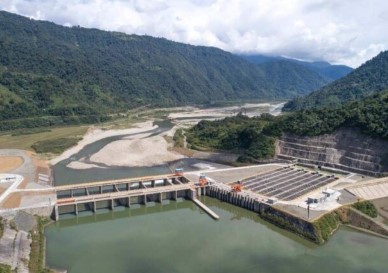Problems persist at Coca Codo Sinclair but Mazar-Paute hydro plants are approaching full production
Despite continuing problems at Coca Codo Sinclair hydroelectric plant, Energy Minister Roberto Luque on Thursday ruled out national blackouts until at least June 2. Previously, he had said there would be no blackouts until May 27.

The Coca Codo Sinclair hydroelectric plant on the Rio Coca in Napo Province went into service in 2016.
“Hydrological conditions are rapidly improving at the Mazar-Paute complex and the three generation stations there are approaching capacity,” Luque said. On Wednesday, the Mazar reservoir was only 14 meters below optimum level as a result of recent rains. Two weeks ago, the reservoir was down 24 meters.
Luque said power outages in several locations on Tuesday and Wednesday were necessary for maintenance work at four generation plants and did not indicate a new shortage of electricity. “We needed to suspend service for periods of one to two hours to conduct cleaning and repair operations as well as to make repairs to transmission lines,” he said. “We are still catching up on neglected maintenance and more work remains to be done.”
Recurring operational problems at Coca Codo Sinclair, located in Napo Province 60 miles east of Quito, remain the major short-term challenge for the country’s electric supply, Luque said. “We were forced to shut down the facility for four hours Wednesday to manually clean out sediment at input points to the turbines,” he said, adding that a team of consultants is on site studying possible solutions.
Advertised originally by former President Rafael Correa as a power plant that would provide 100% of Ecuador’s electricity for 20 years, Coca Codo Sinclair has fallen far short of expectations and has been plagued by problems since going into operation in 2016.
According to Luque, the problems began during the design stage when the flow rate of the Rio Coca was miscalculated. “The calculations were taken during high-flow periods and didn’t accurately represent average flow. As a result, the power generation has never reached even 50% of capacity predictions,” he says.
In addition, two independent engineering reviews revealed that Chinese contractor Sinohydro used sub-standard steel and concrete in construction, resulting in thousands of cracks to moving parts and water tunnels through the dam. “Today, we are all aware of the corruption surrounding the project and the millions of dollars in bribes paid by Sinohydro to the government officials overseeing construction,” says Luque. “It’s obvious that those responsible for quality control put self-interest above the interests of the country.”
The immediate problem, also a design flaw according to Luque, is the inability of input screens at the dam to keep sediment out of the turbines. “The catchment system has never been able to handle the amount of material flowing to the turbines. It was not designed for the soil conditions of the Coca River, which means power generation must be frequently suspended to allow manual cleaning.” According to the Energy Ministry, generation was suspended on 23 occasions at Coca Coda during the past 12 months for cleaning.
The government has sued Sinohydro for project defects, but no court date has been set.

















